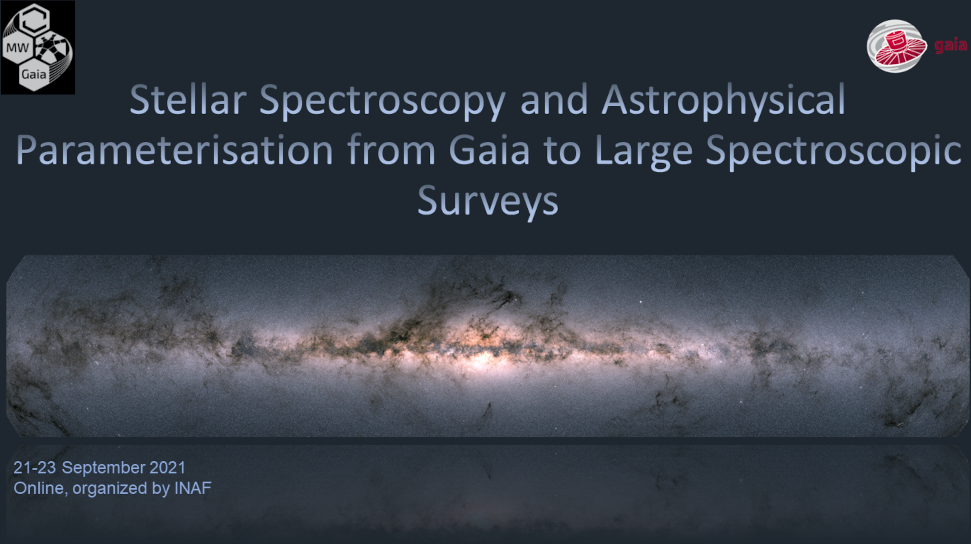*** Note that all times are CEST (Rome, Italy time) ***
Day one – September 21, 2021
Session 1: Spectroscopic Surveys
Chair: Lorenzo Spina
9:00-10:00 A. Vallenari – Present and future large spectroscopic surveys
10:00-10:20 coffee break
10:20-11:20 A. Bragaglia – Large spectroscopic surveys: scientific cases & outcomes
Session 2: Participant presentations (10 min each, including questions)
Chair Angela Bragaglia
11:20-11:30 Elias Kyritsis- A new automated tool for the spectral classification of OB stars
11:30-11:40 Maria Luisa Garcia Vargas-MEGASTAR,MEGARA-GTC Stellar Spectral Library
11:40-11:50 Mingjie Jian-Helium spectral lines at 10830Å: observational trends with stellar parameters
11:50-12:00 Jake Clark - How do Stellar Surveys Like GALAH and GAIA Improve Our Understanding of Planetary Systems?
12:00-12:10 Eduardo Machado Pereira -New candidates for chromospherically young, kinematically old objects
12:10-12:20 Andrea Mejías- Characterization of low mass stars with multiwavelenght large surveys
12:20-12:30 Juan Carbajo-Hijarrubia-Spectroscopic analysis at OCCASO survey.
12:30-12:40 Jose Luis Schiappacasse Ulloa -Lithium abundances to trace the polluter of the second-generation stars in NGC 6752
12:40-12:50 Vikrant Jadhav- Characterisation of Galactic blue stragglers with Gaia data
12:50-13:00 Natalia Posiłek - Spectroscopic analysis of chemically peculiar Am stars observed by TESS. (moved to Day 2)
13:00-14:30 lunch break
Session 3: Classical Methods
Chair Rosanna Sordo
14:30-16:30 C. Sneden – Classical spectroscopy, EW & synthesis
Day two – September 22, 2021
Session 4: Calibration
Chair Antonella Vallenari
9:00-10:00 E. Pancino – Survey-to-survey comparison & homogenization
**Session 5: Tutorials **
Chair Antonella Vallenari
10:00-12:00 M. Tsantaki – Classical methods for spectroscopy (tutorial)
15 min coffee break within
12:00-12:30 S. Blanco-Cuaresma -ispec (tutorial)
Session 6: Participant presentations (10 min each, including questions)
Chair Oleg Malkov
12:30-12:40 Stephanie Monty -Probing the chemo-dynamic history of the Milky Way at the 0.1 dex level: coupling detected high resolution spectroscopy with Gaia DR2
12:40-12:50 Francesca Lucertini- Sulfur abundances in the Galactic Bulge and disk
12:50-13:00 Aleksandra Avdeeva- Combining Gaia, LAMOST and RAVE data for the determination of interstellar extinction
13:00-13:10 Natalia Posiłek - Spectroscopic analysis of chemically peculiar Am stars observed by TESS. (moved from Day 1)
13:10-14:30 lunch break
Session 7: Differential spectroscopy
Chair Oleg Malkov
14:30-16:30 J. Melendez – Differential spectroscopy: method & science cases
Day three – September 23, 2021
Session 8: Spectroscopy with machine learning
Chair Maria Tsantaki
9:00-11:00 R. Andrae – Gaia XP spectra & data driven analysis
11:00-11:15 coffee break
11:15-12:15 A. Recio-Blanco – Gaia RVS spectra
12:15-13:15 L. Spina – Machine learning methods: The Cannon & The Payne
13:15-14:30 lunch break
Chair Sergi Blanco-Cuaresma
14:30-15:30 L. Spina – Machine learning methods: The Cannon & The Payne (part 2)
Session 9: Publication skills
Chair Sergi Blanco-Cuaresma
15:30-16:30 C. Sneden – How to write a paper

